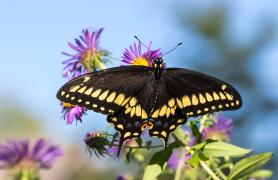Growing up, I enjoyed many days on the banks of Missouri streams. My father and I spent hours fishing for whatever was biting. During the lazy days of summer, we often waded and fished a stretch of stream from sunrise to sunset. Sometimes we took a small aluminum boat out on the water to get closer to the fish. No brush pile, weed bed, or rocky riprap was safe from our lures while we were in that boat. Even if we didn’t catch a single fish, it was still a good day on the water. There was so much to see — basking red-eared sliders, bright yellow prothonotary warblers, and playful mink along the stream’s bank.
Fast forward to the present, and I’m still enthused about viewing Missouri’s wildlife from my light blue kayak, floating leisurely on the Gasconade, Niangua, or Piney.
A Kayak Can Bring You Closer to Nature
Kayaks come in many sizes, styles, and designs. Some enthusiasts prefer sit-in styles, while others swear by sit on- tops. Each has its advantages and disadvantages, and individual selection comes down to research, recreational purpose, and personal preferences. Generally speaking, a wider kayak provides a more stable float. For less wind resistance, a style with lower sides is a good choice. The double-bladed paddle allows for rhythmic, carefree, side-to-side solo steering. With no motor sound or bright flashes of metallic aluminum, a kayak can bring you closer to nature.
Fishing
It was my passion for fishing that led me to choose a kayak over a boat or canoe.
Owning, maintaining, and storing a boat can be costly. Transportation can also be a problem, especially if you have a small vehicle. Canoes are an option, but they are often heavier and more cumbersome. In my case, a small, lightweight kayak wasthe answer. At less than 40 pounds, the 9.5-foot kayak I chose was manageable without a lot of muscle. It was easy to secure and transport on my vehicle’s roof and store in the garage.
Equipped with only a rod and a fishing vest for gear, I became almost one with the water in my kayak, sneaking up on spooky trout and other game fish. I launched my kayak below my intended fishing area andpaddled upstream. On the float back, I often fished areas that looked promising — submerged logs, large rocks, and weed beds. Soon, I was using my kayak for more than just fishing. Bird-watching, which I usually enjoyed in tandem with fishing, became even more enjoyable in a kayak.
Bird-Watching
Birds are wary of their surroundings. With keen eyesight and hearing, they are quick to take cover or flight whenever danger approaches. A softly paddled kayak offers a closer view of our feathered friends in their natural habitat.
Kayakers who combine paddling with birding have the opportunity to see many species across the seasons. Wood ducks with young hatchlings, least bitterns with fuzzy-topped chicks, and the noisy raucous calls from heron rookeries are the sights and sounds of summer floats. Belted kingfishers perch high on tree branches to zero in on fish in the clear waters below, while Louisiana waterthrushes animate shorelines with their twisting and bobbing motions. Fall and winter outings allow for raptor sightings, including hawks and eagles.
I prefer kayaking during the spring migration. Nature comes alive with the chorus songs of colorful warblers, thrushes, and vireos. Resident birds also become more vocal during spring.
Wildlife Photography
Sunrise and sunset are prime times for breathtaking views on the river. In calm waters, a kayak allows for a rather stable float, so you can zoom in on the scenery. The low sides of a kayak can help tremendously with wind issues.
Wildlife pay less attention when you’re stealthily paddling a kayak than when you’re walking around in waders trying to get a good snapshot. Streamside animals go about their daily routine and may swim quite close as you drift along. Kayakers frequently observe muskrats, mink, otter, and beaver.
Seeing your expensive camera and other equipment take a swim is always a fear while on the water, but for me the opportunities to capture interesting wildlife photographs make it worth the risk. I keep high-tech equipment, such as cameras and binoculars, tightly enclosed in a dry-float bag until I am in calmer waters.
Nature Journaling
If fishing is slow, I often take out my nature journal and write or sketch about my outing. While adrift in easy water, I am particularly fond of recording observations in my bird journal. I also like to keep careful notes on water conditions and any new submerged sandbars or debris hazards since my past float trips. I also keep a running log, complete with dates and locations, of any wildlife and scenery photographs I have taken.
All you need is a small notebook and a pencil, and entries can vary from simple sketches to in-depth narratives. Over time, you will build a valuable record for future reference and to recall special memories.
Safety First
Just like other boats and canoes, kayaks come with risks and responsibilities. Make sure you invest in a good-quality personal flotation device (aka life jacket) and wear it when you’re on the water. For those new to kayaking, there are many experienced instructors and outfitters who can provide you with proper instruction regarding paddling techniques and safety tips.
Safety measures include packing a float bag with a first-aid kit and dry clothing. Wet clothing is not only uncomfortable, it can lead to hypothermia in colder temperatures. Also, be mindful of weight and space issues and include the items that are essentialto safety and comfort. To prevent dehydration, be sure to pack plenty of drinking water. Sun protection, insect repellant, and lightweight rain gear should also be part of your kayak’s cargo.
While I enjoy being the captain of my personal kayak, there is great comfort in being in the company of others who share the joys of floating. Having family and friends along while out on the water makes for a safer trip. Inexperienced paddlers should never paddle alone. It is also a good idea to leave a copy of your party’s intendedfloat route and expected time of return with someone that you trust.
Get to know the stream you plan to float. Kayaking a stretch of swift stream requires more paddling skill than a wider channel with calmer water. Keep a careful lookout for debris piles (logjams, rocks), narrow channels, swift shoals, and changes to water depth.
Being aware of current weather conditions can help you stay safe. It is dangerous to be on the water when there is lightning. Should a lightning storm pop up while you’re floating, be sure to bring your kayak to shore immediately and get off the water until the storm passes.
Where to Kayak
Missouri has an abundance of beautiful, floatable rivers and smaller streams. Conservation areas make it easy to get out on the water and enjoy a day of kayaking. MDC maintains public boat ramps and access sites throughout the state. A Paddler’s Guide to Missouri is a comprehensive guide to floating the state’s streams.
It catalogs over 50 of Missouri’s rivers and their tributaries and includes a wealth of information for both novice and experienced paddlers. The booksells for $8 plus tax and shipping. To purchase, call toll free 877-521-8632 or visitmdcnatureshop.com.








Also In This Issue


And More...
This Issue's Staff
Associate Editor - Bonnie Chasteen
Staff Writer - Larry Archer
Staff Writer - Heather Feeler
Staff Writer - Kristie Hilgedick
Staff Writer - Joe Jerek
Creative Director - Stephanie Thurber
Art Director - Cliff White
Designer - Les Fortenberry
Designer - Marci Porter
Photographer - Noppadol Paothong
Photographer - David Stonner
Circulation - Laura Scheuler






















